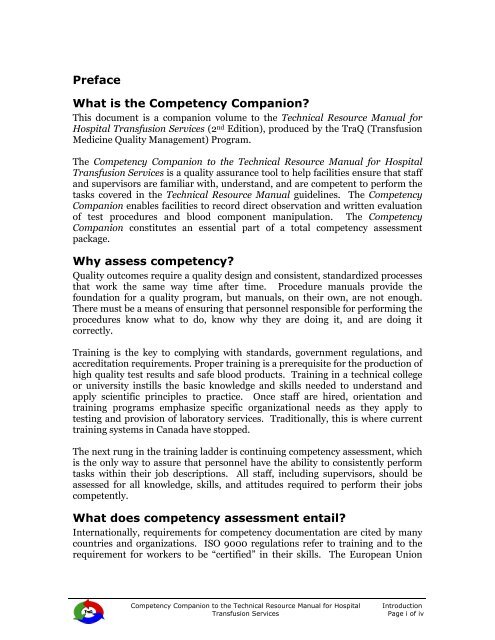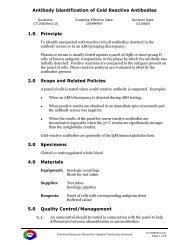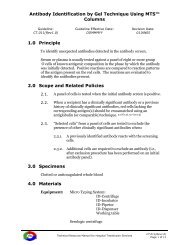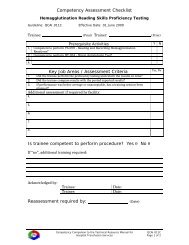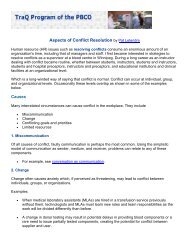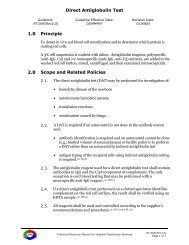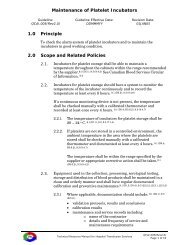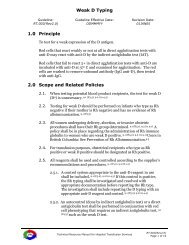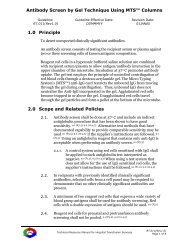Preface What is the Competency Companion? Why assess ...
Preface What is the Competency Companion? Why assess ...
Preface What is the Competency Companion? Why assess ...
You also want an ePaper? Increase the reach of your titles
YUMPU automatically turns print PDFs into web optimized ePapers that Google loves.
<strong>Preface</strong><br />
<strong>What</strong> <strong>is</strong> <strong>the</strong> <strong>Competency</strong> <strong>Companion</strong>?<br />
Th<strong>is</strong> document <strong>is</strong> a companion volume to <strong>the</strong> Technical Resource Manual for<br />
Hospital Transfusion Services (2 nd Edition), produced by <strong>the</strong> TraQ (Transfusion<br />
Medicine Quality Management) Program.<br />
The <strong>Competency</strong> <strong>Companion</strong> to <strong>the</strong> Technical Resource Manual for Hospital<br />
Transfusion Services <strong>is</strong> a quality assurance tool to help facilities ensure that staff<br />
and superv<strong>is</strong>ors are familiar with, understand, and are competent to perform <strong>the</strong><br />
tasks covered in <strong>the</strong> Technical Resource Manual guidelines. The <strong>Competency</strong><br />
<strong>Companion</strong> enables facilities to record direct observation and written evaluation<br />
of test procedures and blood component manipulation. The <strong>Competency</strong><br />
<strong>Companion</strong> constitutes an essential part of a total competency <strong>assess</strong>ment<br />
package.<br />
<strong>Why</strong> <strong>assess</strong> competency?<br />
Quality outcomes require a quality design and cons<strong>is</strong>tent, standardized processes<br />
that work <strong>the</strong> same way time after time. Procedure manuals provide <strong>the</strong><br />
foundation for a quality program, but manuals, on <strong>the</strong>ir own, are not enough.<br />
There must be a means of ensuring that personnel responsible for performing <strong>the</strong><br />
procedures know what to do, know why <strong>the</strong>y are doing it, and are doing it<br />
correctly.<br />
Training <strong>is</strong> <strong>the</strong> key to complying with standards, government regulations, and<br />
accreditation requirements. Proper training <strong>is</strong> a prerequ<strong>is</strong>ite for <strong>the</strong> production of<br />
high quality test results and safe blood products. Training in a technical college<br />
or university instills <strong>the</strong> basic knowledge and skills needed to understand and<br />
apply scientific principles to practice. Once staff are hired, orientation and<br />
training programs emphasize specific organizational needs as <strong>the</strong>y apply to<br />
testing and prov<strong>is</strong>ion of laboratory services. Traditionally, th<strong>is</strong> <strong>is</strong> where current<br />
training systems in Canada have stopped.<br />
The next rung in <strong>the</strong> training ladder <strong>is</strong> continuing competency <strong>assess</strong>ment, which<br />
<strong>is</strong> <strong>the</strong> only way to assure that personnel have <strong>the</strong> ability to cons<strong>is</strong>tently perform<br />
tasks within <strong>the</strong>ir job descriptions. All staff, including superv<strong>is</strong>ors, should be<br />
<strong>assess</strong>ed for all knowledge, skills, and attitudes required to perform <strong>the</strong>ir jobs<br />
competently.<br />
<strong>What</strong> does competency <strong>assess</strong>ment entail?<br />
Internationally, requirements for competency documentation are cited by many<br />
countries and organizations. ISO 9000 regulations refer to training and to <strong>the</strong><br />
requirement for workers to be “certified” in <strong>the</strong>ir skills. The European Union<br />
<strong>Competency</strong> <strong>Companion</strong> to <strong>the</strong> Technical Resource Manual for Hospital<br />
Transfusion Services<br />
Introduction<br />
Page i of iv
(EU) guide to GMP refers to continuing training. In <strong>the</strong> United States,<br />
competency <strong>assess</strong>ment <strong>is</strong> required by several agencies and regulations, including<br />
<strong>the</strong> Clinical Laboratory Improvement Amendments of 1988 (CLIA ’88), <strong>the</strong> Food<br />
and Drug Admin<strong>is</strong>tration (FDA), and <strong>the</strong> Health Care Financing Admin<strong>is</strong>tration<br />
(HCFA).<br />
Currently <strong>the</strong>re <strong>is</strong> no regulatory requirement for competency <strong>assess</strong>ment in<br />
transfusion service laboratories in Canada. However, both CSA Standard Z902-<br />
04 and CSTM Standards for Hospital Transfusion Services have personnel<br />
requirements that include training, competency <strong>assess</strong>ment, and records.<br />
Facilities must identify training needs and develop training programs, including<br />
initial and ongoing training; develop, maintain, and document formal<br />
competency <strong>assess</strong>ment programs; <strong>assess</strong> competency following training and at<br />
regular intervals <strong>the</strong>reafter; <strong>assess</strong> effectiveness of training programs at least<br />
annually; implement SOPs and important changes only after staff training <strong>is</strong><br />
complete; maintain documentation of qualifications, training, competency<br />
<strong>assess</strong>ments, continued competence; and implement remedial measures to<br />
correct inadequate performance.<br />
Although CSA Standards are norms of behaviour and best practice, not<br />
regulations, Health Canada encourages health organizations to follow <strong>the</strong><br />
practices and procedures in <strong>the</strong> CSA Standards as <strong>the</strong>y represent <strong>the</strong> current<br />
industry standard for safety. Health Canada will use <strong>the</strong> CSA Standards as one of<br />
several tools employed to develop new federal regulations for blood and blood<br />
components.<br />
The TraQ program recommends that <strong>assess</strong>ment of competency be done upon <strong>the</strong><br />
completion of orientation, annually, and as required for performance<br />
management of technolog<strong>is</strong>ts who rotate or work in <strong>the</strong> transfusion medicine<br />
area of <strong>the</strong> laboratory.<br />
<strong>Competency</strong> programs should evaluate <strong>the</strong>oretical and practical knowledge of<br />
procedures that include, but are not limited to:<br />
• testing of proficiency samples;<br />
• review of work records and/or Quality Control (QC)/Quality Assurance<br />
(QA) records;<br />
• written evaluation; and<br />
• direct observation of test procedures.<br />
How to implement <strong>the</strong> <strong>Competency</strong> <strong>Companion</strong><br />
<strong>Competency</strong> <strong>assess</strong>ment <strong>is</strong> a process that takes large parcels of time to implement<br />
and ongoing resources to maintain. Organizational and time management skills<br />
are paramount in successful implementation.<br />
<strong>Competency</strong> <strong>Companion</strong> to <strong>the</strong> Technical Resource Manual for Hospital<br />
Transfusion Services<br />
Introduction<br />
Page ii of iv
The trainer should be an expert staff member with good communication and<br />
feedback skills. Th<strong>is</strong> person (or persons) may be a superv<strong>is</strong>or or an experienced<br />
technolog<strong>is</strong>t working in <strong>the</strong> transfusion service. Ideally he or she should have<br />
“train <strong>the</strong> trainer” education and/or instructional skills training.<br />
The responsibilities of <strong>the</strong> trainer and <strong>the</strong> responsibilities of <strong>the</strong> trainee are<br />
outlined in separate sections at <strong>the</strong> start of <strong>the</strong> <strong>Competency</strong> <strong>Companion</strong>. Each<br />
individual participating in competency <strong>assess</strong>ment should have <strong>the</strong> opportunity<br />
to read <strong>the</strong>se sections.<br />
The remainder of <strong>the</strong> <strong>Competency</strong> <strong>Companion</strong> cons<strong>is</strong>ts of a series of checkl<strong>is</strong>ts,<br />
written evaluations, and answers to written evaluations that correspond to<br />
guidelines in <strong>the</strong> Technical Resource Manual for Hospital Transfusion Services<br />
(2 nd Edition).<br />
The checkl<strong>is</strong>ts provide predetermined sequences, or cascades, for direct<br />
observation of procedures, which take into account <strong>the</strong> need for prerequ<strong>is</strong>ite<br />
knowledge and competence to perform some of <strong>the</strong> more complex tasks. More<br />
information <strong>is</strong> provided in <strong>the</strong> section on trainer responsibilities.<br />
The written evaluations include questions dealing with <strong>the</strong>ory, technique and<br />
interpretation relevant to <strong>the</strong> guideline and are designed to be answered in<br />
writing by <strong>the</strong> trainee. Written evaluations should be available to all<br />
technolog<strong>is</strong>ts to complete as time permits.<br />
Answers to <strong>the</strong> written evaluations are also provided and referenced to <strong>the</strong><br />
applicable guideline whenever possible. These answers should be available to all<br />
staff to review as required, ei<strong>the</strong>r individually or with <strong>the</strong> trainer.<br />
Evaluation of Success<br />
Effective competency <strong>assess</strong>ment <strong>is</strong> an objective of <strong>the</strong> TraQ program.<br />
Parameters such as <strong>the</strong> number of repeated tests, incident reports, and error logs<br />
would be indicators of improved performance.<br />
We Welcome Your Feedback<br />
The <strong>Competency</strong> <strong>Companion</strong> will be reviewed and updated regularly in<br />
conjunction with <strong>the</strong> Technical Resource Manual. We welcome all user<br />
suggestions for improvement. Please complete Guideline A.002 (in <strong>the</strong> Technical<br />
Resource Manual) to submit feedback and let us know what amendments or<br />
additions would be helpful in meeting your needs.<br />
<strong>Competency</strong> <strong>Companion</strong> to <strong>the</strong> Technical Resource Manual for Hospital<br />
Transfusion Services<br />
Introduction<br />
Page iii of iv
Contributors<br />
Th<strong>is</strong> <strong>Competency</strong> <strong>Companion</strong> was produced by <strong>the</strong> Brit<strong>is</strong>h Columbia Provincial<br />
Blood Coordinating Office under <strong>the</strong> direction of <strong>the</strong> Brit<strong>is</strong>h Columbia Min<strong>is</strong>try of<br />
Health and Min<strong>is</strong>try Responsible for Seniors.<br />
FIRST EDITION<br />
Project Leader<br />
Kathy Chambers ART<br />
Lead Writer<br />
Diane Krancenblum ART<br />
The <strong>Competency</strong> <strong>Companion</strong> was developed simultaneously with <strong>the</strong> Technical<br />
Resource Manual for Hospital Transfusion Services. It was developed and<br />
reviewed by <strong>the</strong> Transfusion Medicine Technical Resource Group (TRG),<br />
cons<strong>is</strong>ting of:<br />
Carol Stanley, ART (Chair) | Leslie B<strong>is</strong>gard, ART | Kathy Burnie, FCSLT<br />
Kathy Chambers, ART | Debbie Dau, RT | Nancy Harvey, ART<br />
Sharon Herd, ART | Hea<strong>the</strong>r Mah, BSc, RT | Nancy McFarlane, RT<br />
Kathy O’Shea, BSc, MT (ASCP), SBB, ART | Willa Os<strong>is</strong>, RT | Cathy Villar, ART<br />
Editorial ass<strong>is</strong>tance: Shannon Selin<br />
Admin<strong>is</strong>trative ass<strong>is</strong>tance: Carol Griffiths<br />
SECOND EDITION<br />
Writing Team<br />
Pat Letendre, BSc, RT (IH), MEd | Bev Padget ART | Maureen Patterson ART<br />
Reviewers<br />
Laverne Finch | Sheila de Groot, BSc, RT | Maureen Wyatt ART<br />
Admin<strong>is</strong>trative ass<strong>is</strong>tance: Aimee Beauchamp<br />
Waiver of Liability<br />
The information contained in th<strong>is</strong> document <strong>is</strong> intended to serve as a guideline<br />
only. It <strong>is</strong> in no way intended to represent a provincial requirement for<br />
transfusion medicine practice. Nei<strong>the</strong>r <strong>the</strong> contributing authors nor <strong>the</strong> Brit<strong>is</strong>h<br />
Columbia Provincial Blood Coordinating Office shall be liable for any actions,<br />
claims, damages, costs or obligations that may ar<strong>is</strong>e from <strong>the</strong> use or m<strong>is</strong>use of <strong>the</strong><br />
material contained within.<br />
<strong>Competency</strong> <strong>Companion</strong> to <strong>the</strong> Technical Resource Manual for Hospital<br />
Transfusion Services<br />
Introduction<br />
Page iv of iv


